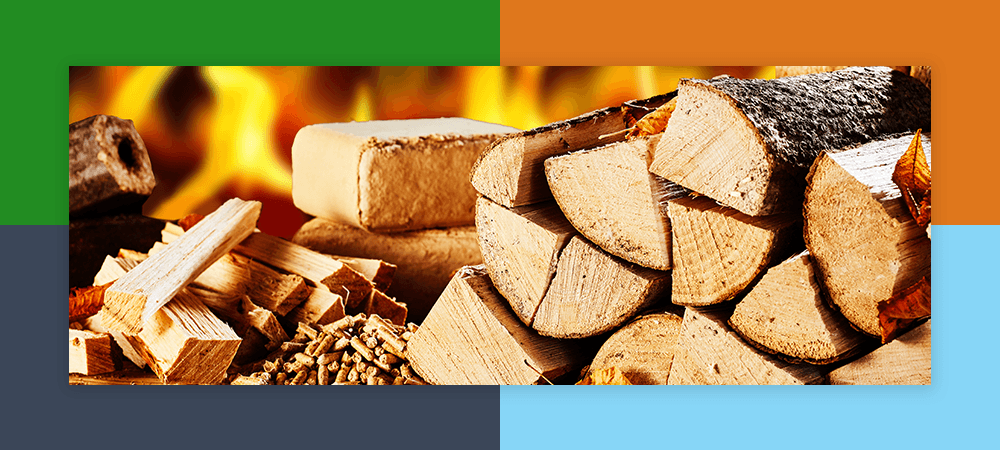The best wood for boilers and all wood-burning appliances is undoubtedly dry wood, regardless of species. Dry wood is generally 20% or lower moisture content by weight. In the Eastern U.S., it is difficult to dry firewood below 15% with natural drying. Achieving moisture content below 15% is more likely in arid regions of the U.S. West, especially with coniferous woods like pine, spruce, and fir. EPA-certified wood boilers with automatic, variable air controls installed with heat storage can handle any species of dry firewood- hardwood or softwood- while providing high efficiency and very low emissions.
Hardwoods will provide the most heat per cord than softwood, usually 30-50% or more. However, moisture content is always the most important consideration. Because definitions of dry and/or seasoned firewood vary widely, it is best to purchase green firewood well before the wood is burned. Green firewood is generally less expensive, and you know what you are getting. Green firewood should be stacked in top-covered rows with the end grain of the rows open to air and, ideally, sun. Covering the entire row with a tarp traps moisture and is not recommended. If the wood is stacked as described above by May, it should be close to 20% moisture content by November. Some woods, such as oak and hickory, do not dry quickly. For slow-drying woods like oak and hickory, an additional year of drying is recommended. We have reports that by drying wood for an extra year, wood consumption has been reduced by 20%. In other words, 20% of the wood had been wasted evaporating water during the burn cycle when the water could have been removed by air drying. Remember, dry fuel will provide the most efficiency while producing the least smoke and creosote.
What Is the Best Firewood Species for a Boiler?
So what about the species of wood? Some of the best hardwood types include ash, oak, beech, yellow birch and maple. In the Western U.S., wood species are often more limited. Cedar, fir and hemlock contain more heat per cord than pines and spruce. By knowing the various wood types and factors to look for, you can select the best option for your needs, whether processing cordwood on your property or purchasing it elsewhere.
While you can burn many kinds of wood in a wood boiler, your best option is hardwood. Hardwoods come from deciduous trees, which grow slowly and are more dense than softwoods, which come from evergreen trees. Each hardwood log can produce up to 50% more heat output than softwoods due to the increased density.
Here are a few hardwoods to choose from and the benefits of each:
Ash: This wood produces low smoke and provides plenty of heat. It's also readily available for now. Ash dries out faster than most other hardwoods, and it's easy to split. Though ash has slightly lower energy content than other hardwoods in this list, its' natural dryness and easy splitting make it premium firewood. In the Eastern U.S., sadly, ash is being destroyed by the Emerald Ash Borer. Because this invasive is so completely destroying ash trees, ash should be targeted firewood, especially if the ash tree(s) may be sheltering other trees that will mature into desirable and valuable trees. Where ash is still healthy, it likely won’t be for long.
Oak: Oak is often sought after and regarded as one of the best fuels, providing a slow burn and long-lasting heat. One downside of oak is that the drying process takes at least two years. A second downside of oak is that it contains acids that can be harmful to boiler refractory and steel, especially in condensate. If boilers are burned hot and fast, oak should not be a problem, as condensate is avoided.
Maple: You can find maple throughout the United States, making it a popular choice. Maple also has similar qualities to ash. Sugar maple has considerably more heat than soft maple, but both species make good firewood.
Yellow Birch: Unlike the immediately recognizable white birch, yellow birch is a much harder wood with a higher fuel value. Yellow birch does not rot as quickly as white birch when left unsplit. One downside of yellow birch is that it can be a difficult wood to split.
Beech: This wood has a high water content, which makes the drying process take longer. Even so, dried beech results in cordwood that burns well in a wood boiler. Much of the beech in the Northeast is diseased and will not mature into marketable logs. Diseased beech, therefore is a good option for firewood.
While each hardwood has pros and cons, they provide a higher heat output than softwoods. Wood is measured in cords — stacks of wood measuring 4 feet by 4 feet by 8 feet. A hardwood cord typically produces about 24,000,000 British Thermal Units (BTUs), while softwood averages only 18,000,000 BTUs.
Firewood BTU of Western Hardwood Species
| Species | Million BTU's per Cord | Pounds Per Cord Green |
Pounds Per Cord Dry |
| Live Oak | 36.6 | 7870 | 4840 |
| Eucalyptus | 34.5 | 7320 | 4560 |
| Manzanita | 32 | ||
| Pacific Madrone | 30.9 | 6520 | 4086 |
| Dogwood | 30.4 | 6520 | 4025 |
| Oregon White Oak | 28 | 6290 | 3710 |
| Tanoak | 27.5 | 6070 | 3650 |
| California Black Oak | 27.4 | 5725 | 3625 |
| Pepperwood (Myrtle) | 26.1 | 5730 | 3450 |
| Chinquapin | 24.7 | 4720 | 3450 |
| Bigleaf Maple | 22.7 | 4940 | 3000 |
| Red Alder | 19.5 | 4100 | 2600 |
| Quaking Aspen | 18 | 3880 | 2400 |
| Cottonwood | 16.8 | 3475 | 2225 |
Firewood BTU of Western Softwood Species
| Species | Million BTU's per Cord | Pounds Per Cord Green |
Pounds Per Cord Dry |
| Douglas Fir | 26.5 | 5050 | 3075 |
| Western Juniper | 26.4 | 5410 | 3050 |
| Western Hemlock | 24.4 | 5730 | 2830 |
| Port Orford Cedar | 23.4 | 4370 | 2700 |
| Lodgepole Pine | 22.3 | 4270 | 2580 |
| Ponderosa Pine | 21.7 | 4270 | 2520 |
| Jeffery Pine | 21.7 | 4270 | 2520 |
| Sitka Spruce | 21.7 | 4100 | 2520 |
| White Fir | 21.1 | 3190 | 2400 |
| Red Fir | 20.6 | 4040 | 2400 |
| Incense Cedar | 20.1 | 3880 | 2350 |
| Coast Redwood | 20.1 | 4040 | 2330 |
| Grand Fir | 20.1 | 3880 | 2330 |
| Sugar Pine | 19.6 | 3820 | 2270 |
Firewood BTU of Eastern Hardwood Species
| Species | Million BTU's per Cord | Pounds Per Cord Dry |
| Osage Orange | 32.9 | 4728 |
| Shagbark Hickory | 27.7 | 4327 |
| Eastern Hornbeam | 27.1 | 4016 |
| Black Birch | 26.8 | 3890 |
| Black Locust | 26.8 | 3890 |
| Blue Beech | 26.8 | 3890 |
| Ironwood | 26.8 | 3890 |
| Bitternut Hickory | 26.5 | 3832 |
| Honey Locust | 26.5 | 4100 |
| Apple | 25.8 | 3712 |
| Mulberry | 25.7 | 4012 |
| Beech | 24 | 3757 |
| Northern Red Oak | 24 | 3757 |
| Sugar Maple | 24 | 3757 |
| White Oak | 24 | 3757 |
| White Ash | 23.6 | 3689 |
| Yellow Birch | 21.8 | 3150 |
| Red Elm | 21.6 | 3112 |
| Hackberry | 20.8 | 3247 |
| Kentucky Coffeetree | 20.8 | 3247 |
| Gray Birch | 20.3 | 3179 |
| Paper Birch | 20.3 | 3179 |
| White Birch | 20.2 | 3192 |
| Black Walnut | 20 | 3120 |
| Cherry | 20 | 3120 |
| Green Ash | 19.9 | 2880 |
| Black Cherry | 19.5 | 2880 |
| American Elm | 19.5 | 3052 |
| White Elm | 19.5 | 3052 |
| Sycamore | 19.1 | 2992 |
| Black Ash | 18.7 | 2924 |
| Red Maple (Soft Maple) | 18.1 | 2900 |
| Boxelder | 17.9 | 2797 |
| Catalpa | 15.9 | 2482 |
| Aspen | 14.7 | 2295 |
| Butternut | 14.5 | 2100 |
| Willow | 14.3 | 2236 |
| Cottonwood | 13.5 | 2108 |
| American Basswood | 13.5 | 2108 |
Firewood BTU of Eastern Softwood Species
| Species | Million BTU's per Cord | Pounds Per Cord Dry |
| Rocky Mountain Juniper | 21.6 | 3112 |
| Tamarack | 20.8 | 3247 |
| Jack Pine | 17.1 | 2669 |
| Norway Pine | 17.1 | 2669 |
| Pitch Pine | 17.1 | 2669 |
| Hemlock | 15.9 | 2482 |
| Black Spruce | 15.9 | 2482 |
| Eastern White Pine | 14.3 | 2236 |
| Balsam Fir | 14.3 | 2236 |
| Eastern White Cedar | 12.2 | 1913 |
Ensuring the Best Wood for Wood Burning
There are many rules of thumb for checking if wood is dry enough to burn well. Key features of dry, ready to burn wood are:
- The wood will feel lighter
- The wood should not have any odor
- Bark may loosen or fall off. Some species are more apt to have loose bark than others.
- The end of the firewood will be cracked/checked.
Despite the above rules of thumb, the best way to know when wood is dry enough to burn is to check the wood with a moisture meter. Moisture meters are not expensive and are widely available from internet-based merchants. To properly check moisture content, split the wood open and check the inside of the freshly split wood. Importantly, insert the moisture meter probes parallel with the wood grain. Measurements of the end grain or the outside edge of firewood are almost always useless.
Contact Tarm Biomass for Wood Boilers
The cordwood you choose makes a difference, and so does your wood boiler. Tarm Biomass provides high-efficiency wood boilers and more. Contact us to learn more about choosing a wood boiler and fuel.


